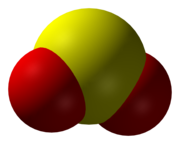
| |

| |

| |
| Names | |
|---|---|
| IUPAC name
Sulfur dioxide
| |
| Other names
Sulfurous anhydride
Sulfur(IV) oxide | |
| Identifiers | |
3D model (JSmol)
|
|
| 3535237 | |
| ChEBI | |
| ChEMBL | |
| ChemSpider | |
| ECHA InfoCard | 100.028.359 |
| EC Number |
|
| E number | E220 (preservatives) |
| 1443 | |
| KEGG | |
| MeSH | Sulfur+dioxide |
PubChem CID
|
|
| RTECS number |
|
| UNII | |
| UN number | 1079, 2037 |
CompTox Dashboard (EPA)
|
|
| Properties | |
|---|---|
| SO 2 | |
| Molar mass | 64.066 g mol−1 |
| Appearance | Colorless and pungent gas |
| Odor | Pungent; similar to a just-struck match[1] |
| Density | 2.6288 kg m−3[citation needed] |
| Melting point | −72 °C; −98 °F; 201 K |
| Boiling point | −10 °C (14 °F; 263 K) |
| 94 g/L[2] forms sulfurous acid | |
| Vapor pressure | 230 kPa at 10 °C; 330 kPa at 20 °C; 462 kPa at 30 °C; 630 kPa at 40 °C[3] |
| Acidity (pKa) | ~1.81 |
| Basicity (pKb) | ~12.19 |
| −18.2·10−6 cm3/mol | |
| Viscosity | 12.82 μPa·s[4] |
| Structure | |
| C2v | |
| Digonal | |
| Dihedral | |
| 1.62 D | |
| Thermochemistry | |
Std molar
entropy (S⦵298) |
248.223 J K−1 mol−1 |
Std enthalpy of
formation (ΔfH⦵298) |
−296.81 kJ mol−1 |
| Hazards | |
| GHS labelling: | |
 
| |
| Danger | |
| H314, H331[5] | |
| NFPA 704 (fire diamond) | |
| Lethal dose or concentration (LD, LC): | |
LC50 (median concentration)
|
3000 ppm (mouse, 30 min) 2520 ppm (rat, 1 hr)[7] |
LCLo (lowest published)
|
993 ppm (rat, 20 min) 611 ppm (rat, 5 hr) 764 ppm (mouse, 20 min) 1000 ppm (human, 10 min) 3000 ppm (human, 5 min)[7] |
| NIOSH (US health exposure limits): | |
PEL (Permissible)
|
TWA 5 ppm (13 mg/m3)[6] |
REL (Recommended)
|
TWA 2 ppm (5 mg/m3) ST 5 ppm (13 mg/m3)[6] |
IDLH (Immediate danger)
|
100 ppm[6] |
| Related compounds | |
| Sulfur monoxide Sulfur trioxide Disulfur monoxide | |
Related compounds
|
Ozone |
Except where otherwise noted, data are given for materials in their standard state (at 25 °C [77 °F], 100 kPa).
| |
Sulfur dioxide (IUPAC-recommended spelling) or sulphur dioxide (traditional Commonwealth English) is the chemical compound with the formula SO
2. It is a toxic gas responsible for the odor of burnt matches. It is released naturally by volcanic activity and is produced as a by-product of copper extraction and the burning of sulfur-bearing fossil fuels.[8]
https://en.wikipedia.org/wiki/Sulfur_dioxide

No comments:
Post a Comment